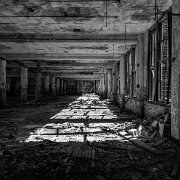
1 The Packard Pland, Detroit Michigan
The Packard Plant, located on East Grand Boulevard in Detroit, Michigan, was once a symbol of American industrial prowess. Opened in 1903 by the Packard Motor Car Company, the factory became one of the largest and most advanced automobile manufacturing plants of its time. Designed by the architect Albert Kahn, it was a sprawling complex covering over 40 acres, consisting of multiple buildings connected by an intricate system of railways and assembly lines. The plant was at the forefront of automotive innovation, producing luxury vehicles and employing thousands of workers. Throughout the early 20th century, Packard cars were synonymous with quality and craftsmanship, catering to an elite clientele. At its peak, the Packard Plant was a hub of activity, contributing significantly to Detroit’s status as the "Motor City."
However, the decline of the Packard Motor Car Company in the mid-20th century led to the eventual abandonment of the plant. By the 1950s, competition from other automakers, changing consumer tastes, and financial mismanagement led to Packard’s demise. In 1956, the company ceased operations at the plant, and the building fell into disrepair. Despite various attempts to revitalize the site, including plans for residential and commercial development, the Packard Plant remains a striking symbol of Detroit's industrial past. The site became an iconic ruin, attracting photographers, urban explorers, and those fascinated by the history of the automobile industry.
As of March 2025, all but 2 of the buildings have been demolished
The Packard Plant, located on East Grand Boulevard in Detroit, Michigan, was once a symbol of American industrial prowess. Opened in 1903 by the Packard Motor Car Company, the factory became one of the largest and most advanced automobile manufacturing plants of its time. Designed by the architect Albert Kahn, it was a sprawling complex covering over 40 acres, consisting of multiple buildings connected by an intricate system of railways and assembly lines. The plant was at the forefront of automotive innovation, producing luxury vehicles and employing thousands of workers. Throughout the early 20th century, Packard cars were synonymous with quality and craftsmanship, catering to an elite clientele. At its peak, the Packard Plant was a hub of activity, contributing significantly to Detroit’s status as the "Motor City."
However, the decline of the Packard Motor Car Company in the mid-20th century led to the eventual abandonment of the plant. By the 1950s, competition from other automakers, changing consumer tastes, and financial mismanagement led to Packard’s demise. In 1956, the company ceased operations at the plant, and the building fell into disrepair. Despite various attempts to revitalize the site, including plans for residential and commercial development, the Packard Plant remains a striking symbol of Detroit's industrial past. The site became an iconic ruin, attracting photographers, urban explorers, and those fascinated by the history of the automobile industry.
As of March 2025, all but 2 of the buildings have been demolished
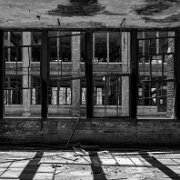
2 The Packard Pland, Detroit Michigan
The Packard Plant, located on East Grand Boulevard in Detroit, Michigan, was once a symbol of American industrial prowess. Opened in 1903 by the Packard Motor Car Company, the factory became one of the largest and most advanced automobile manufacturing plants of its time. Designed by the architect Albert Kahn, it was a sprawling complex covering over 40 acres, consisting of multiple buildings connected by an intricate system of railways and assembly lines. The plant was at the forefront of automotive innovation, producing luxury vehicles and employing thousands of workers. Throughout the early 20th century, Packard cars were synonymous with quality and craftsmanship, catering to an elite clientele. At its peak, the Packard Plant was a hub of activity, contributing significantly to Detroit’s status as the "Motor City."
However, the decline of the Packard Motor Car Company in the mid-20th century led to the eventual abandonment of the plant. By the 1950s, competition from other automakers, changing consumer tastes, and financial mismanagement led to Packard’s demise. In 1956, the company ceased operations at the plant, and the building fell into disrepair. Despite various attempts to revitalize the site, including plans for residential and commercial development, the Packard Plant remains a striking symbol of Detroit's industrial past. The site became an iconic ruin, attracting photographers, urban explorers, and those fascinated by the history of the automobile industry.
As of March 2025, all but 2 of the buildings have been demolished
The Packard Plant, located on East Grand Boulevard in Detroit, Michigan, was once a symbol of American industrial prowess. Opened in 1903 by the Packard Motor Car Company, the factory became one of the largest and most advanced automobile manufacturing plants of its time. Designed by the architect Albert Kahn, it was a sprawling complex covering over 40 acres, consisting of multiple buildings connected by an intricate system of railways and assembly lines. The plant was at the forefront of automotive innovation, producing luxury vehicles and employing thousands of workers. Throughout the early 20th century, Packard cars were synonymous with quality and craftsmanship, catering to an elite clientele. At its peak, the Packard Plant was a hub of activity, contributing significantly to Detroit’s status as the "Motor City."
However, the decline of the Packard Motor Car Company in the mid-20th century led to the eventual abandonment of the plant. By the 1950s, competition from other automakers, changing consumer tastes, and financial mismanagement led to Packard’s demise. In 1956, the company ceased operations at the plant, and the building fell into disrepair. Despite various attempts to revitalize the site, including plans for residential and commercial development, the Packard Plant remains a striking symbol of Detroit's industrial past. The site became an iconic ruin, attracting photographers, urban explorers, and those fascinated by the history of the automobile industry.
As of March 2025, all but 2 of the buildings have been demolished
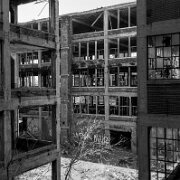
3 The Packard Pland, Detroit Michigan
The Packard Plant, located on East Grand Boulevard in Detroit, Michigan, was once a symbol of American industrial prowess. Opened in 1903 by the Packard Motor Car Company, the factory became one of the largest and most advanced automobile manufacturing plants of its time. Designed by the architect Albert Kahn, it was a sprawling complex covering over 40 acres, consisting of multiple buildings connected by an intricate system of railways and assembly lines. The plant was at the forefront of automotive innovation, producing luxury vehicles and employing thousands of workers. Throughout the early 20th century, Packard cars were synonymous with quality and craftsmanship, catering to an elite clientele. At its peak, the Packard Plant was a hub of activity, contributing significantly to Detroit’s status as the "Motor City."
However, the decline of the Packard Motor Car Company in the mid-20th century led to the eventual abandonment of the plant. By the 1950s, competition from other automakers, changing consumer tastes, and financial mismanagement led to Packard’s demise. In 1956, the company ceased operations at the plant, and the building fell into disrepair. Despite various attempts to revitalize the site, including plans for residential and commercial development, the Packard Plant remains a striking symbol of Detroit's industrial past. The site became an iconic ruin, attracting photographers, urban explorers, and those fascinated by the history of the automobile industry.
As of March 2025, all but 2 of the buildings have been demolished
The Packard Plant, located on East Grand Boulevard in Detroit, Michigan, was once a symbol of American industrial prowess. Opened in 1903 by the Packard Motor Car Company, the factory became one of the largest and most advanced automobile manufacturing plants of its time. Designed by the architect Albert Kahn, it was a sprawling complex covering over 40 acres, consisting of multiple buildings connected by an intricate system of railways and assembly lines. The plant was at the forefront of automotive innovation, producing luxury vehicles and employing thousands of workers. Throughout the early 20th century, Packard cars were synonymous with quality and craftsmanship, catering to an elite clientele. At its peak, the Packard Plant was a hub of activity, contributing significantly to Detroit’s status as the "Motor City."
However, the decline of the Packard Motor Car Company in the mid-20th century led to the eventual abandonment of the plant. By the 1950s, competition from other automakers, changing consumer tastes, and financial mismanagement led to Packard’s demise. In 1956, the company ceased operations at the plant, and the building fell into disrepair. Despite various attempts to revitalize the site, including plans for residential and commercial development, the Packard Plant remains a striking symbol of Detroit's industrial past. The site became an iconic ruin, attracting photographers, urban explorers, and those fascinated by the history of the automobile industry.
As of March 2025, all but 2 of the buildings have been demolished
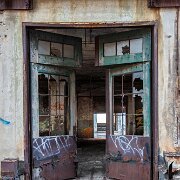
4 The Packard Pland, Detroit Michigan
The Packard Plant, located on East Grand Boulevard in Detroit, Michigan, was once a symbol of American industrial prowess. Opened in 1903 by the Packard Motor Car Company, the factory became one of the largest and most advanced automobile manufacturing plants of its time. Designed by the architect Albert Kahn, it was a sprawling complex covering over 40 acres, consisting of multiple buildings connected by an intricate system of railways and assembly lines. The plant was at the forefront of automotive innovation, producing luxury vehicles and employing thousands of workers. Throughout the early 20th century, Packard cars were synonymous with quality and craftsmanship, catering to an elite clientele. At its peak, the Packard Plant was a hub of activity, contributing significantly to Detroit’s status as the "Motor City."
However, the decline of the Packard Motor Car Company in the mid-20th century led to the eventual abandonment of the plant. By the 1950s, competition from other automakers, changing consumer tastes, and financial mismanagement led to Packard’s demise. In 1956, the company ceased operations at the plant, and the building fell into disrepair. Despite various attempts to revitalize the site, including plans for residential and commercial development, the Packard Plant remains a striking symbol of Detroit's industrial past. The site became an iconic ruin, attracting photographers, urban explorers, and those fascinated by the history of the automobile industry.
As of March 2025, all but 2 of the buildings have been demolished
The Packard Plant, located on East Grand Boulevard in Detroit, Michigan, was once a symbol of American industrial prowess. Opened in 1903 by the Packard Motor Car Company, the factory became one of the largest and most advanced automobile manufacturing plants of its time. Designed by the architect Albert Kahn, it was a sprawling complex covering over 40 acres, consisting of multiple buildings connected by an intricate system of railways and assembly lines. The plant was at the forefront of automotive innovation, producing luxury vehicles and employing thousands of workers. Throughout the early 20th century, Packard cars were synonymous with quality and craftsmanship, catering to an elite clientele. At its peak, the Packard Plant was a hub of activity, contributing significantly to Detroit’s status as the "Motor City."
However, the decline of the Packard Motor Car Company in the mid-20th century led to the eventual abandonment of the plant. By the 1950s, competition from other automakers, changing consumer tastes, and financial mismanagement led to Packard’s demise. In 1956, the company ceased operations at the plant, and the building fell into disrepair. Despite various attempts to revitalize the site, including plans for residential and commercial development, the Packard Plant remains a striking symbol of Detroit's industrial past. The site became an iconic ruin, attracting photographers, urban explorers, and those fascinated by the history of the automobile industry.
As of March 2025, all but 2 of the buildings have been demolished

6 Upon its completion the Michigan Theater could seat 4,050 patrons, In addition to films in its prime years, the theatre hosted performances of bands led by John Philip Sousa, Benny Goodman, Jimmy Dorsey and Harry James as well as live performances by The Marx Brothers, Betty Grable and Bob Hope.[4]
The theater ceased operations in 1976 after operating as a nightclub named The Michigan Palace. The office tenants threatened to leave unless they received adequate parking. To retain the tenants, building owners gutted and converted the theater into a parking structure. The theater could not be completely demolished and replaced by a parking structure because it is integral to the structure of the office building. The ornate plaster ceiling of the theater auditorium and grand lobby, at the ninth floor level, are still intact, as are parts of the mezzanine, the 2nd and 3rd balcony foyers and their staircases. The projection booth is also still intact.
The theater ceased operations in 1976 after operating as a nightclub named The Michigan Palace. The office tenants threatened to leave unless they received adequate parking. To retain the tenants, building owners gutted and converted the theater into a parking structure. The theater could not be completely demolished and replaced by a parking structure because it is integral to the structure of the office building. The ornate plaster ceiling of the theater auditorium and grand lobby, at the ninth floor level, are still intact, as are parts of the mezzanine, the 2nd and 3rd balcony foyers and their staircases. The projection booth is also still intact.
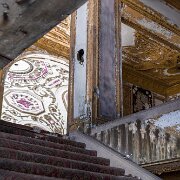
7 Upon its completion the Michigan Theater could seat 4,050 patrons, In addition to films in its prime years, the theatre hosted performances of bands led by John Philip Sousa, Benny Goodman, Jimmy Dorsey and Harry James as well as live performances by The Marx Brothers, Betty Grable and Bob Hope.[4]
The theater ceased operations in 1976 after operating as a nightclub named The Michigan Palace. The office tenants threatened to leave unless they received adequate parking. To retain the tenants, building owners gutted and converted the theater into a parking structure. The theater could not be completely demolished and replaced by a parking structure because it is integral to the structure of the office building. The ornate plaster ceiling of the theater auditorium and grand lobby, at the ninth floor level, are still intact, as are parts of the mezzanine, the 2nd and 3rd balcony foyers and their staircases. The projection booth is also still intact.
The theater ceased operations in 1976 after operating as a nightclub named The Michigan Palace. The office tenants threatened to leave unless they received adequate parking. To retain the tenants, building owners gutted and converted the theater into a parking structure. The theater could not be completely demolished and replaced by a parking structure because it is integral to the structure of the office building. The ornate plaster ceiling of the theater auditorium and grand lobby, at the ninth floor level, are still intact, as are parts of the mezzanine, the 2nd and 3rd balcony foyers and their staircases. The projection booth is also still intact.
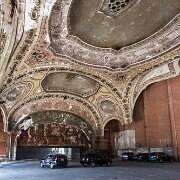
8 Upon its completion the Michigan Theater could seat 4,050 patrons, In addition to films in its prime years, the theatre hosted performances of bands led by John Philip Sousa, Benny Goodman, Jimmy Dorsey and Harry James as well as live performances by The Marx Brothers, Betty Grable and Bob Hope.[4]
The theater ceased operations in 1976 after operating as a nightclub named The Michigan Palace. The office tenants threatened to leave unless they received adequate parking. To retain the tenants, building owners gutted and converted the theater into a parking structure. The theater could not be completely demolished and replaced by a parking structure because it is integral to the structure of the office building. The ornate plaster ceiling of the theater auditorium and grand lobby, at the ninth floor level, are still intact, as are parts of the mezzanine, the 2nd and 3rd balcony foyers and their staircases. The projection booth is also still intact.
The theater ceased operations in 1976 after operating as a nightclub named The Michigan Palace. The office tenants threatened to leave unless they received adequate parking. To retain the tenants, building owners gutted and converted the theater into a parking structure. The theater could not be completely demolished and replaced by a parking structure because it is integral to the structure of the office building. The ornate plaster ceiling of the theater auditorium and grand lobby, at the ninth floor level, are still intact, as are parts of the mezzanine, the 2nd and 3rd balcony foyers and their staircases. The projection booth is also still intact.
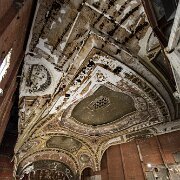
9 Upon its completion the Michigan Theater could seat 4,050 patrons, In addition to films in its prime years, the theatre hosted performances of bands led by John Philip Sousa, Benny Goodman, Jimmy Dorsey and Harry James as well as live performances by The Marx Brothers, Betty Grable and Bob Hope.[4]
The theater ceased operations in 1976 after operating as a nightclub named The Michigan Palace. The office tenants threatened to leave unless they received adequate parking. To retain the tenants, building owners gutted and converted the theater into a parking structure. The theater could not be completely demolished and replaced by a parking structure because it is integral to the structure of the office building. The ornate plaster ceiling of the theater auditorium and grand lobby, at the ninth floor level, are still intact, as are parts of the mezzanine, the 2nd and 3rd balcony foyers and their staircases. The projection booth is also still intact.
The theater ceased operations in 1976 after operating as a nightclub named The Michigan Palace. The office tenants threatened to leave unless they received adequate parking. To retain the tenants, building owners gutted and converted the theater into a parking structure. The theater could not be completely demolished and replaced by a parking structure because it is integral to the structure of the office building. The ornate plaster ceiling of the theater auditorium and grand lobby, at the ninth floor level, are still intact, as are parts of the mezzanine, the 2nd and 3rd balcony foyers and their staircases. The projection booth is also still intact.
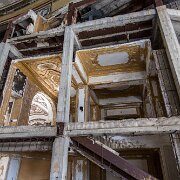
10 Upon its completion the Michigan Theater could seat 4,050 patrons, In addition to films in its prime years, the theatre hosted performances of bands led by John Philip Sousa, Benny Goodman, Jimmy Dorsey and Harry James as well as live performances by The Marx Brothers, Betty Grable and Bob Hope.[4]
The theater ceased operations in 1976 after operating as a nightclub named The Michigan Palace. The office tenants threatened to leave unless they received adequate parking. To retain the tenants, building owners gutted and converted the theater into a parking structure. The theater could not be completely demolished and replaced by a parking structure because it is integral to the structure of the office building. The ornate plaster ceiling of the theater auditorium and grand lobby, at the ninth floor level, are still intact, as are parts of the mezzanine, the 2nd and 3rd balcony foyers and their staircases. The projection booth is also still intact.
The theater ceased operations in 1976 after operating as a nightclub named The Michigan Palace. The office tenants threatened to leave unless they received adequate parking. To retain the tenants, building owners gutted and converted the theater into a parking structure. The theater could not be completely demolished and replaced by a parking structure because it is integral to the structure of the office building. The ornate plaster ceiling of the theater auditorium and grand lobby, at the ninth floor level, are still intact, as are parts of the mezzanine, the 2nd and 3rd balcony foyers and their staircases. The projection booth is also still intact.

11 Upon its completion the Michigan Theater could seat 4,050 patrons, In addition to films in its prime years, the theatre hosted performances of bands led by John Philip Sousa, Benny Goodman, Jimmy Dorsey and Harry James as well as live performances by The Marx Brothers, Betty Grable and Bob Hope.[4]
The theater ceased operations in 1976 after operating as a nightclub named The Michigan Palace. The office tenants threatened to leave unless they received adequate parking. To retain the tenants, building owners gutted and converted the theater into a parking structure. The theater could not be completely demolished and replaced by a parking structure because it is integral to the structure of the office building. The ornate plaster ceiling of the theater auditorium and grand lobby, at the ninth floor level, are still intact, as are parts of the mezzanine, the 2nd and 3rd balcony foyers and their staircases. The projection booth is also still intact.
The theater ceased operations in 1976 after operating as a nightclub named The Michigan Palace. The office tenants threatened to leave unless they received adequate parking. To retain the tenants, building owners gutted and converted the theater into a parking structure. The theater could not be completely demolished and replaced by a parking structure because it is integral to the structure of the office building. The ornate plaster ceiling of the theater auditorium and grand lobby, at the ninth floor level, are still intact, as are parts of the mezzanine, the 2nd and 3rd balcony foyers and their staircases. The projection booth is also still intact.
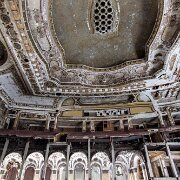
12 Upon its completion the Michigan Theater could seat 4,050 patrons, In addition to films in its prime years, the theatre hosted performances of bands led by John Philip Sousa, Benny Goodman, Jimmy Dorsey and Harry James as well as live performances by The Marx Brothers, Betty Grable and Bob Hope.[4]
The theater ceased operations in 1976 after operating as a nightclub named The Michigan Palace. The office tenants threatened to leave unless they received adequate parking. To retain the tenants, building owners gutted and converted the theater into a parking structure. The theater could not be completely demolished and replaced by a parking structure because it is integral to the structure of the office building. The ornate plaster ceiling of the theater auditorium and grand lobby, at the ninth floor level, are still intact, as are parts of the mezzanine, the 2nd and 3rd balcony foyers and their staircases. The projection booth is also still intact.
The theater ceased operations in 1976 after operating as a nightclub named The Michigan Palace. The office tenants threatened to leave unless they received adequate parking. To retain the tenants, building owners gutted and converted the theater into a parking structure. The theater could not be completely demolished and replaced by a parking structure because it is integral to the structure of the office building. The ornate plaster ceiling of the theater auditorium and grand lobby, at the ninth floor level, are still intact, as are parts of the mezzanine, the 2nd and 3rd balcony foyers and their staircases. The projection booth is also still intact.

13 The Park Avenue Building is a 12-story beaux-arts high-rise located at 2001-2017 Park Avenue in the Park Avenue Historic District in downtown Detroit, Michigan. Architected by Albert Kahn
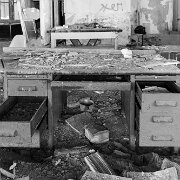
14 The Park Avenue Building is a 12-story beaux-arts high-rise located at 2001-2017 Park Avenue in the Park Avenue Historic District in downtown Detroit, Michigan. Architected by Albert Kahn
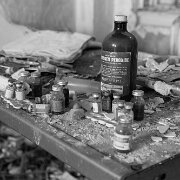
15 The Park Avenue Building is a 12-story beaux-arts high-rise located at 2001-2017 Park Avenue in the Park Avenue Historic District in downtown Detroit, Michigan. Architected by Albert Kahn
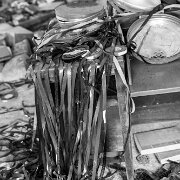
16 The Park Avenue Building is a 12-story beaux-arts high-rise located at 2001-2017 Park Avenue in the Park Avenue Historic District in downtown Detroit, Michigan. Architected by Albert Kahn
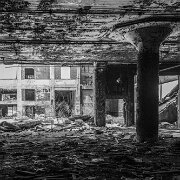
17 The Packard Pland, Detroit Michigan
The Packard Plant, located on East Grand Boulevard in Detroit, Michigan, was once a symbol of American industrial prowess. Opened in 1903 by the Packard Motor Car Company, the factory became one of the largest and most advanced automobile manufacturing plants of its time. Designed by the architect Albert Kahn, it was a sprawling complex covering over 40 acres, consisting of multiple buildings connected by an intricate system of railways and assembly lines. The plant was at the forefront of automotive innovation, producing luxury vehicles and employing thousands of workers. Throughout the early 20th century, Packard cars were synonymous with quality and craftsmanship, catering to an elite clientele. At its peak, the Packard Plant was a hub of activity, contributing significantly to Detroit’s status as the "Motor City."
However, the decline of the Packard Motor Car Company in the mid-20th century led to the eventual abandonment of the plant. By the 1950s, competition from other automakers, changing consumer tastes, and financial mismanagement led to Packard’s demise. In 1956, the company ceased operations at the plant, and the building fell into disrepair. Despite various attempts to revitalize the site, including plans for residential and commercial development, the Packard Plant remains a striking symbol of Detroit's industrial past. The site became an iconic ruin, attracting photographers, urban explorers, and those fascinated by the history of the automobile industry.
As of March 2025, all but 2 of the buildings have been demolished
The Packard Plant, located on East Grand Boulevard in Detroit, Michigan, was once a symbol of American industrial prowess. Opened in 1903 by the Packard Motor Car Company, the factory became one of the largest and most advanced automobile manufacturing plants of its time. Designed by the architect Albert Kahn, it was a sprawling complex covering over 40 acres, consisting of multiple buildings connected by an intricate system of railways and assembly lines. The plant was at the forefront of automotive innovation, producing luxury vehicles and employing thousands of workers. Throughout the early 20th century, Packard cars were synonymous with quality and craftsmanship, catering to an elite clientele. At its peak, the Packard Plant was a hub of activity, contributing significantly to Detroit’s status as the "Motor City."
However, the decline of the Packard Motor Car Company in the mid-20th century led to the eventual abandonment of the plant. By the 1950s, competition from other automakers, changing consumer tastes, and financial mismanagement led to Packard’s demise. In 1956, the company ceased operations at the plant, and the building fell into disrepair. Despite various attempts to revitalize the site, including plans for residential and commercial development, the Packard Plant remains a striking symbol of Detroit's industrial past. The site became an iconic ruin, attracting photographers, urban explorers, and those fascinated by the history of the automobile industry.
As of March 2025, all but 2 of the buildings have been demolished
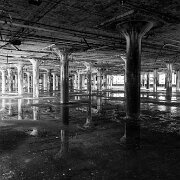
18 Fisher Body Plant 21, located on Piquette Avenue in Detroit, was built in 1919 as part of the Fisher Body Company, which supplied automobile bodies to General Motors (GM). This four-story, reinforced concrete structure was designed in a style characteristic of early 20th-century industrial architecture, emphasizing both functionality and durability. It quickly became a vital hub for producing car bodies, including for popular brands like Cadillac and Buick. Fisher Body was an influential name in the automotive industry, known for pioneering techniques in mass production. At its peak, Fisher Plant 21 employed hundreds of workers who contributed to Detroit’s burgeoning status as the "Motor City."
In 1926, Fisher Body was fully absorbed by General Motors, which continued to operate Plant 21 as a central manufacturing facility. During World War II, the plant shifted gears from car bodies to military production, reflecting Detroit's broader transformation into the "Arsenal of Democracy." After the war, Fisher Plant 21 returned to automobile manufacturing, contributing to the post-war boom in American car culture. However, as the automotive industry evolved, many older plants faced obsolescence, and Plant 21 eventually ceased production in the late 1970s.
In 1926, Fisher Body was fully absorbed by General Motors, which continued to operate Plant 21 as a central manufacturing facility. During World War II, the plant shifted gears from car bodies to military production, reflecting Detroit's broader transformation into the "Arsenal of Democracy." After the war, Fisher Plant 21 returned to automobile manufacturing, contributing to the post-war boom in American car culture. However, as the automotive industry evolved, many older plants faced obsolescence, and Plant 21 eventually ceased production in the late 1970s.
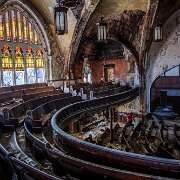
19 The Woodward Avenue Presbyterian Church is a church located at 8501 Woodward Avenue in Detroit, Michigan. Built in 1911 in the Gothic revival style, the architect was Sidney Badgley. It was used for some time as the Abyssinia Church of God in Christ. The building was listed on the National Register of Historic Places in 1982
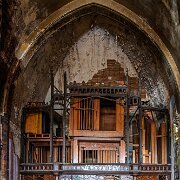
20 The Woodward Avenue Presbyterian Church is a church located at 8501 Woodward Avenue in Detroit, Michigan. Built in 1911 in the Gothic revival style, the architect was Sidney Badgley. It was used for some time as the Abyssinia Church of God in Christ. The building was listed on the National Register of Historic Places in 1982
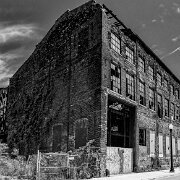
Detroit